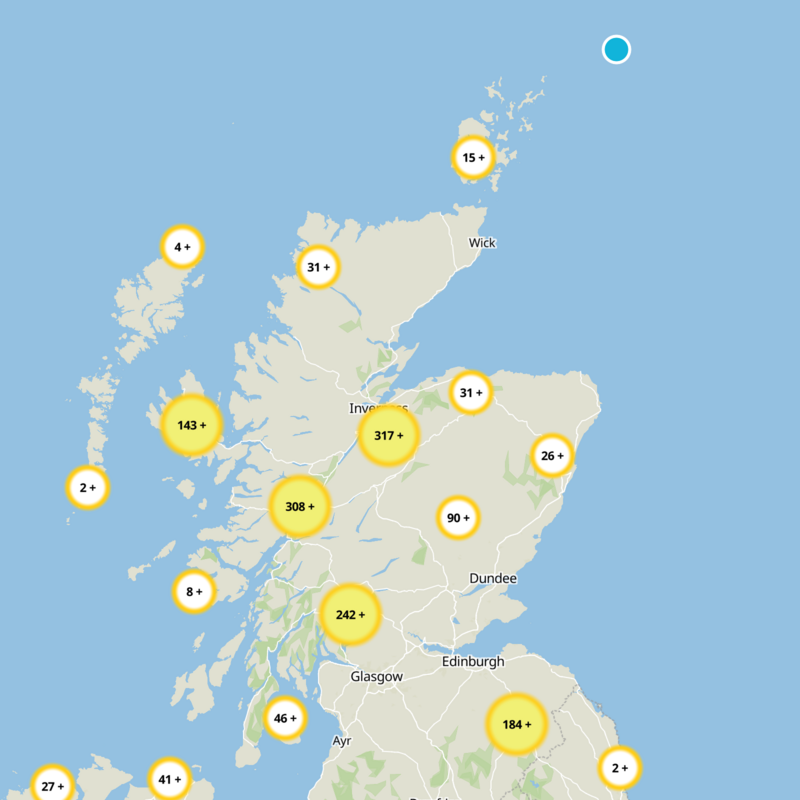What to expect
Scotland has 1538 trails
including medium, easy, difficult, and extra difficult trails.
The trail with the highest elevation climb is the John Muir Country Park Loop
and the one with the least climb is the Coastal Walk of Shetland - East.
The longest trail is The Great British Walk
at 1730 km. To complete this hike you should budget at least 67 days.
For a shorter adventure, you can try the Clootie Well Trail
a t 217 m. This could be done in as little as 1 days.
Trails with the best offering of hostels include
West Highland and Rob Roy Way Circular, Kelvin Walkway, Sgùrr na Cìche, Gala Loop via Upland Way, and Ben Starav and Stob Coir'an Albannaich Loop Trail.

FAQs about hiking in Scotland

Scotland's climate shifts with each season, requiring keen attention for hiking adventures. The mild, potentially wet spring months are invigorating, with blossoming flora and longer daylight hours enhancing the scenic experience. Rainproof gear is essential to counter unpredictable showers. More at https://www.mwis.org.uk/forecasts/scottish.
Summers, typically June to August, offer the most hospitable hiking climate. Though occasionally rainy, the temperatures hover around a comfortable 15°C - 20°C, with up to 18 hours of daylight to fully exploit the trails. Careful monitoring of midge activity is vital for a hassle-free experience. https://www.livebreathescotland.com/midges-in-scotland/
Autumn brings a dazzling display of changing colours, but the weather, much like spring, can be erratic. Temperatures begin to drop, and daylight hours shrink rapidly, restricting hiking time. Winters are challenging with shorter days, snowfall, and icy trails. For the experienced, it presents a unique, exhilarating challenge. Check https://www.mountaineering.scot/. Best to avoid winter unless highly experienced.
Summers, typically June to August, offer the most hospitable hiking climate. Though occasionally rainy, the temperatures hover around a comfortable 15°C - 20°C, with up to 18 hours of daylight to fully exploit the trails. Careful monitoring of midge activity is vital for a hassle-free experience. https://www.livebreathescotland.com/midges-in-scotland/
Autumn brings a dazzling display of changing colours, but the weather, much like spring, can be erratic. Temperatures begin to drop, and daylight hours shrink rapidly, restricting hiking time. Winters are challenging with shorter days, snowfall, and icy trails. For the experienced, it presents a unique, exhilarating challenge. Check https://www.mountaineering.scot/. Best to avoid winter unless highly experienced.

Unlike certain parts of the world, Scotland boasts the "Right to Roam," making hiking unrestricted and accessible. As such, there are no permits required for general hiking. However, wild camping regulations in places like Loch Lomond & The Trossachs National Park require adherence. Details at Wild Camping Guidelines.

In Scotland, wild camping is legal and widely enjoyed by hikers due to the Land Reform (Scotland) Act 2003. Yet, restrictions apply in certain areas, especially from March to September, like Loch Lomond & The Trossachs National Park. It's crucial to respect the Outdoor Access Code. Explore more at Outdoor Access Code.

In case of a hiking emergency in Scotland, contacting the police is paramount as they coordinate with Mountain Rescue teams. Dial 999, ask for Police, then Mountain Rescue. Consider registering with the emergency SMS service for areas with poor signal. Further details at Mountain Rescue Scotland.

Scotland's rich biodiversity paints the trails with varied flora. Expect heather moorlands in the Highlands, ancient woodlands in Caledonian Pine forests, and bluebell fields in spring. Be wary of certain plants like bracken, which can harbor ticks. For more flora information, refer to https://www.nature.scot/plants-animals-and-fungi/flowering-plants.

Scotland's wildlife ranges from benign red deer in the Highlands to the notorious midges prevalent in warm, damp conditions. Caution is advised around adders, Scotland's only venomous snake. Observe marine life in coastal regions. Learn more at https://www.wildguidescotland.com/.












